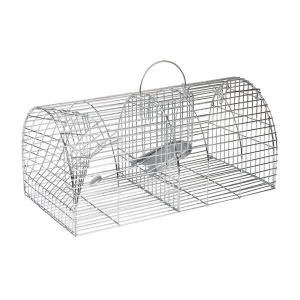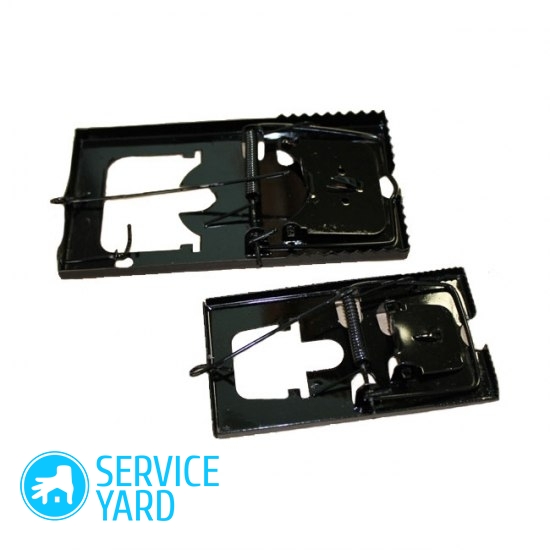Rat trap

Fighting rodents, and especially rats, is rather complicated, and to some extent dangerous, so for the right result you need to choose an effective weapon. An important role in this fight is played by the rat trap. Consider which traps for rats are most effective and whether you can do them yourself.
to contents ↑Features of the fight against rodents
Rats and mice can do serious harm in a short period of time - not only completely destroy food supplies, but also spread the causative agents of infectious diseases. Rats are constantly being fought in storage facilities for agricultural products, food warehouses, and places for keeping pets.
Often rat traps or traps are used in this process. Such devices ensure the environmental friendliness of the fight, as they do not have a negative impact on the environment. Most often, traps for rats are used in apartments, residential buildings and in animal locations, that is, where chemicals cannot be used.
 Despite the efficiency of using traps, it is difficult to massively fight using this method, in this case other methods are used, including chemical ones.
Despite the efficiency of using traps, it is difficult to massively fight using this method, in this case other methods are used, including chemical ones.
If you decide to use mechanical rat traps, then you will need various lures:
- Cottage cheese.
- Bakery products.
- A mixture of cereals.
- Cheese.
- Sausage.
- Smoked meats.
- Rice porridge.
Important! The bait for rats should be fresh and smelling fragrant, since spoiled foods will scare away the tailed “lodger”.
What else to consider when using traps?
- It is necessary to place traps for rats in crowded areas, and best of all near the mink. But first, determine if it is residential. To do this: cover the entrance to the hole with grass or newsprint. If the paper and grass are scattered in the morning, then the “lodger” is in place.
- Set a trap with a bait is necessary against the course of movement of the rodent. Rats usually move primarily along walls, trying to be undetected and avoiding illuminated open areas.
- Rodents avoid contaminated areas if a clean path can be found. The animal, even entangled in a burdock, will not go further until it is released from the last thorn. Therefore, set traps for rats in uncluttered places.
- Traps for catching rats should be perfectly clean. If the mechanism is dirty, then clean it with baking soda and do not forget to ventilate the device.
- It is necessary to carry out hunting for rodents gradually, accustoming them with the help of refreshments on an inactive trap. It is noted that only young rats fall into the trap, and adult individuals, sensing danger, avoid them. In addition, the visual memory of rodents is highly developed - if they saw that a relative fell into the trap, they will continue to avoid it.
- The use of traps in residential premises must be done in compliance with safety precautions:
- Restrict children's access to the device.
- Do not touch a dead rat without protective equipment.
- In parallel with the use of rat traps, it is necessary to prevent rodent control:
- Exclude rat food access.
- Keep all rooms clean.
- Remove all sources of water so that thirst causes rats to leave the room.
Types of rat traps
You can buy a trap for rodents in a specialized store or make it yourself.It should be noted that rat traps and mousetraps differ from each other only in size and power of the mechanism. All pest disposal devices can be divided into 2 types:
- Destroys the rodent.
- Leaves the animal alive, but isolated.
Ready-made rat traps can be of the following types.
Mousetraps
 The easiest and cheapest option. By actuating the spring, the rodent is strongly clamped between the two plates or the arc is pressed against the base of the device. Specialized devices can be made of both wood and metal. The upper part of the structure is necessarily made of metal.
The easiest and cheapest option. By actuating the spring, the rodent is strongly clamped between the two plates or the arc is pressed against the base of the device. Specialized devices can be made of both wood and metal. The upper part of the structure is necessarily made of metal.
Important! The rat trap is usually completely metal, and the device itself is more powerful.
Electric trap
Such a rat trap is a device in which rodents are destroyed by an electric discharge. It is presented in the form of a container with an isolated electric discharge inside.
The device only works if it enters an animal trying to steal the bait. The electric trap operates both from an electric network and from batteries of a certain type. The electric trap is efficient and convenient to use, as well as reliable in operation.
Noose traps
The device has a wooden case with several holes. In the middle of the hull, opposite the holes, a bait is placed, and a loop is made at a distance from the beginning of the entrance to the bait.
During the time when the animal is trying to steal the treat, the noose is triggered and the animals die from suffocation. Since the device has several holes, it is possible in this way to catch several pests.
Live-cell
These designs are made of a wooden base and upper metal frame. Inside the net, a bait is attached to which the pest must respond. As soon as he touches the treat, the trap will close.
Plastic trap houses
The house is a square tube with a door on one side and a bait on the other. The body of such a trap for rats is bent at an angle from the side of the bait. When open, the door rests on the floor. Making his way to the bait, the rodent with its weight tilts the trap and the door slams shut.
Containers Cottages
Traps for rats of this species are designed to capture up to 15 rodents at a time. The design of the device is made of plastic and is a rectangular container with several holes on the sides. The strong box has a removable tray, and bait is put into it.
Glue pad
The device is a surface coated with glue (sticky composition). The bait is placed on the platform. The rodent, rushing to the treat, gets on the site and sticks to it.
to contents ↑DIY rat extermination
We offer you several options that have positively proven homemade rat traps.
Option number 1. Flower pot trap
You will need:
- A flower pot or other heavy container.
- Bait.
- “Gatehouse” in the form of a piece of plastic or fiberboard.
Step-by-step instructions for manufacturing:
- Prepare a piece of plastic so that it has a flat part and a pointed end.
- Attach the bait to the end of the gatehouse.
- Turn the pot over and place it on the gatehouse with one edge and the other on the floor.
Operating principle:

The rodent, penetrating inside, will try to pull off a piece of food. As a result of his actions, the “gatehouse” will shift from the rib, and the pot will cover the rodent.
Important! For convenience, set a trap on plywood. After the animal is captured, it will be easier to throw it out and at the same time the likelihood of undermining is reduced.
Option number 2. Bucket trap
- Prepare a bucket or other deep container.
- Fill the container with concentrated saline.
- Pour buckwheat, flaxseed or other husk (or sawdust) onto the surface of the liquid.
Important! The husk layer should be fairly thick and even.
- Place a few pieces of goodies on the husk.
- Substitute a ladder (piece of wood) to the bucket.
Principle of action: the husk in saline will not sink and close the liquid. A rodent, hitting the top layer, will damage it and drown.
Option number 3. Plastic bottle trap
For a homemade trap, cook:
- Plastic bottle (1.5 L or more).
- Fishing line.
- Bait (bread with drops of unrefined sunflower oil).
- Scissors or knife.
Method of manufacture and use:
- Cut off the neck of a plastic bottle so that the rodent can climb inside.
- Cut a small hole at the top of the bottle.
- Tie a piece of twine or fishing line through the hole.
- Secure the other end of the twine so that the trap hangs on it.
- Place the lure inside the device.
- Set the trap on the edge of the table.
Important! To prevent the bottle from slipping, place it on a piece of cloth.
- Find a suitable place to install the mousetrap: rodents should have access to the neck of the container, and the trap should hang freely on the twine when capsizing.
Option number 4. Cylinder trap
For construction, cans, plastic bottles or other cylindrical vessels can be used. It is best to use a cylinder trap in houses, barns, so that you can bury it in a deep and long ditch.
Operating principle:
The rodent, getting inside, cannot get out, since the walls of the cylinder are perfectly even.
Option number 5. Cell
To make a cell with your own hands you will need:
- Fine mesh
- Wire.
- 2 magnets.
- Nippers.
Preparation method:
- Cut out the sides of the future cage. All of them are needed 6. One of them will be used as a door.
Important! The easiest way is to make a square trap with equal sides.
- Fasten 5 sides together using wire to make a box.
- Attach the door on one side.
- In the place of contact of the cage and the door, wrap magnets with wire.
- Attach a piece of wire to the door, and draw its free end into the cage through the hinges.
- Place a heavy bait on the end of the wire inside the box. She will pull the door up and prevent her from closing.
Operating principle:
When the pest removes food from the wire, the door closes and the magnet prevents the rodent from opening it.
We hope that you can choose a reliable and acceptable trap for uninvited guests, make it yourself or purchase in specialized stores.
to contents ↑Stock footage
You can experiment and use a win-win option - alabaster. This method has been known for over a hundred years: mix flour and alabaster in equal proportions, place the product near the rodent's holes. Place a container of water nearby so that the treat swells and asphalts the stomach of the animal. What method and means to use, choose yourself, if only it is safe for you and your loved ones. Have a good hunting!
- How to choose a vacuum cleaner taking into account the characteristics of the house and coatings?
- What to look for when choosing a water delivery
- How to quickly create comfort at home - tips for housewives
- How to choose the perfect TV - useful tips
- What to look for when choosing blinds
- What should be running shoes?
- What useful things can you buy in a hardware store
- Iphone 11 pro max review
- Than iPhone is better than Android smartphones



